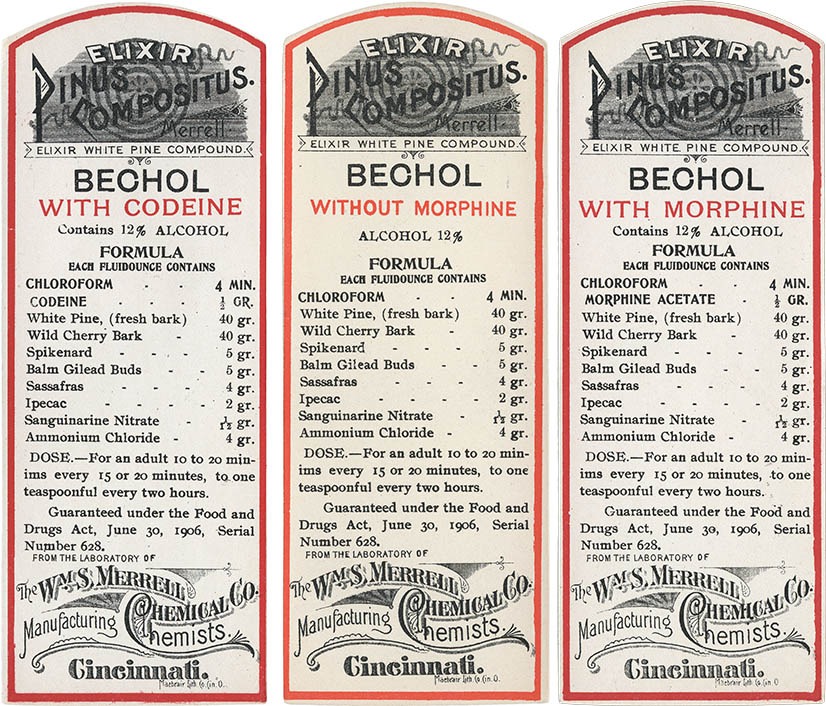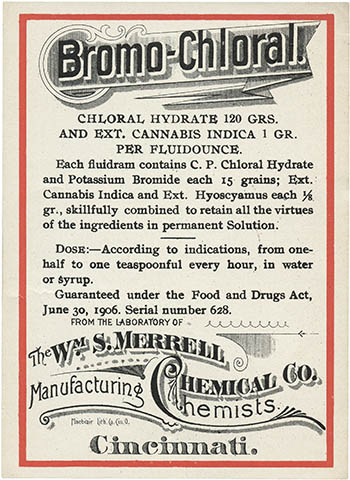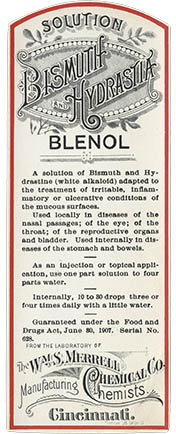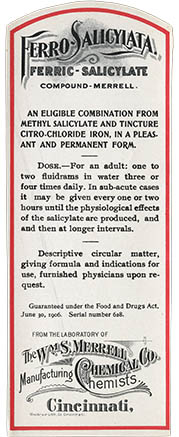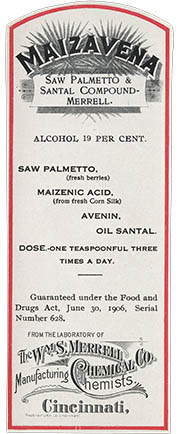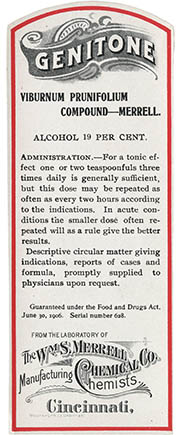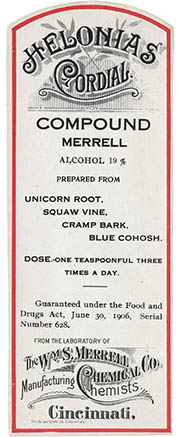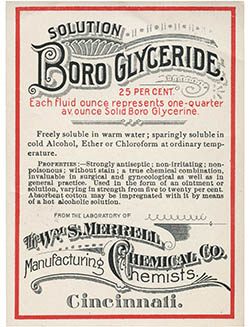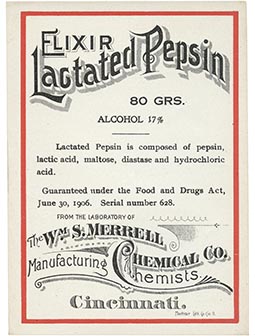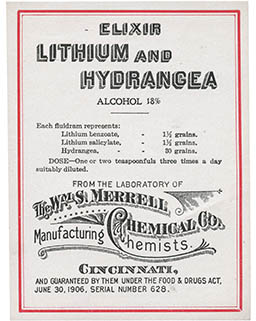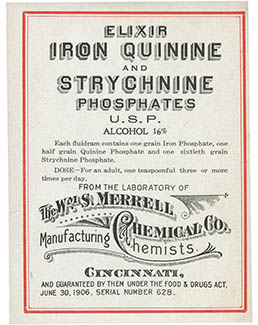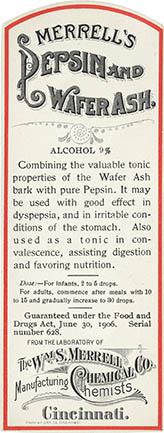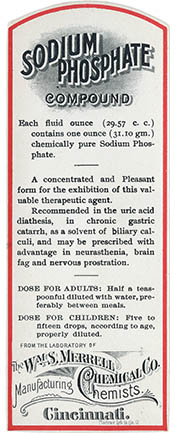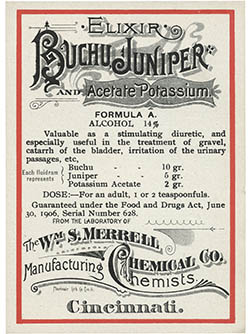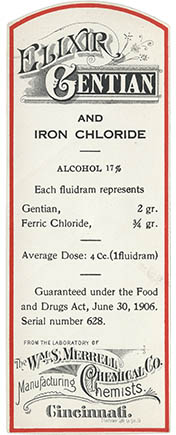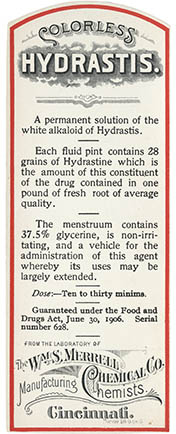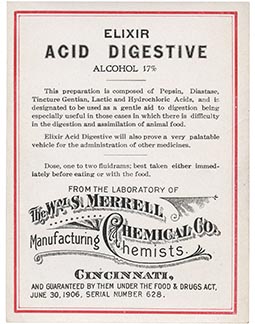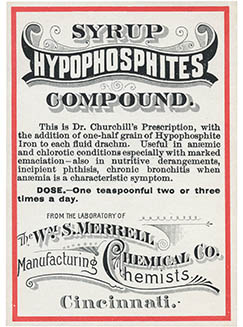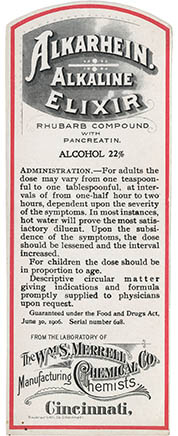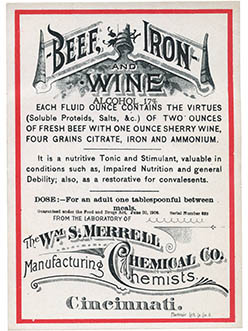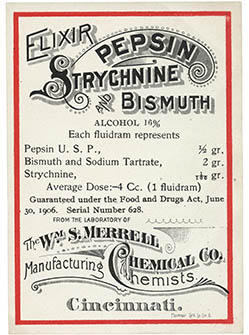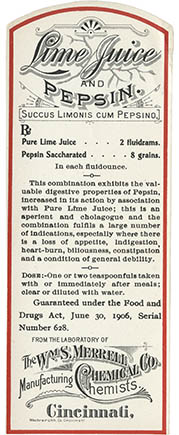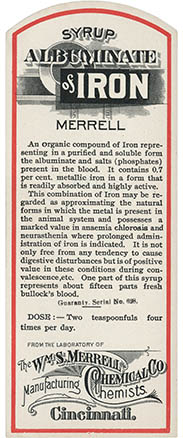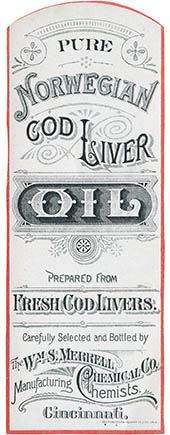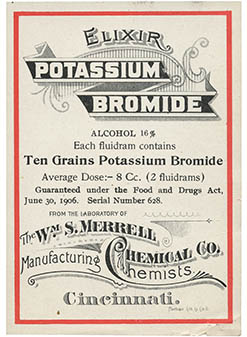84
The William S. Merrell Co.
Electrotypes on Drugs
These labels (actually sample labels as they were never affixed to a bottle) were for William S. Merrell’s Bechol family of Pinus Compositus formulations and date to ca.1907–1910. The elixirs contained extracts of wholesome white pine and cherry bark, as well as chloroform, ipecac, ammonia, and if you picked up the right bottle at the pharmacy, codeine or morphine, all in a 12% alcohol solution.1
If the alcohol + chloroform + morphine content seems somewhat alarming, don’t worry: the elixirs were guaranteed by Merrell under the Food and Drug Act of 30 Jun 1906.2 Here is another classic formula, again completely guaranteed:
William Stanley Merrell (8 Jan 1798 – 4 Sept 1880) received a chemistry degree from Hamilton College in 1824 and began teaching preparatory school chemistry in Cincinnati. In 1828 he opened the Western Market Apothecary at Sixth Street and Western Row in downtown Cincinnati. Merrell turned out to be more of a research scientist than a merchant and in 1832 he began to manufacture drugs for other pharmacies.
His wholesale drug business became quite successful and by the 1870s he was supplying ingredients to pharmacies throughout the US and Europe. After his death in 1880 his sons incorporated the business as the William S. Merrell Chemical Company.3
These lithographic labels, newly designed to meet the requirements of the 1906 Food and Drug Act, featured a relatively consistant layout and a distinctive colored border. The high point, however, was the drug name and company logo. These designs, from electrotypes likely prepared by Merrell’s printer MacBrair & Sons of Cincinnati,4 feature completely wonderful and excessive post-Victorian typography and ornamentation. Taken together the effect is rather like reading an early 20th century type specimen book. Here is a detail:
This approach to drug label design: a standardized label with wildly varying type treatments was the typical pharmaceutical industry design practice until Max Schmid’s identity work for Geigy in the 1950s and 60s.
Merrell’s green bordered labels were for “natural medicines” or plant extracts:
1. If you want to try to make these at home here are the appropriate Apothecary weights and measures (for conversions use: 1 gr. = 64.8 mg or 1 ♏ = 0.062 mL):
1 pound (℔) = 12 ounces (℥) = 96 drams (ℨ) = 288 scruples (℈) = 5760 grains (gr.)
1 gallon (Cong.) = 8 pints (O) = 128 fluid ounces (f℥) = 1024 fluid drams (fℨ) = 61440 minims (♏).
2. The Food and Drug Act of 1906 required medications to be labelled with their ingredients (particularly narcotics, cocaine and cannabis) and largely put an end to patent medications. Note, however, that it didn’t outlaw any of these ingredients, it just required them to be properly labelled.
3. The company history goes something like this: William. S. Merrell (incorporated 14 Jul 1881) → Richardson-Merrell (1932) → Merrell Dow (1980) → Marion Merrell Dow (1989) → Hoechst Marion Roussel (1995, sold for 7.1 billion USD) → Sanofi-Aventis (1999).
Perhaps the most notable event on the company’s 167-year history was their planned US introduction of thalidomide (as Kevadon). In 1960 Merrell licensed the drug from the German company Chemie Grünenthal but a brand new reviewer at the FDA, Dr. Frances Oldham Kelsey, refused the application on the grounds that it needed more clinical studies. Merrell argued that the drug, already widely used in Europe, was completely safe. It was soon found that thalidomide, commonly prescribed as a morning-sickness treatment, was exceptionally teratogenic and caused phocomelia (Google it). A disaster was averted in the US but some 10,000+ thalidomide babies were born in Europe.
You would think that would be the end of thalidomide, but you would be wrong. Thalidimid® (Celgene) is now available through a registry program to treat several conditions, including multiple myeloma. Here is the package insert.
4. Archibald MacBrair (26 Feb 1805 – 1882) immigrated to Cincinnati from Scotland around 1855 and opened a printing and lithography shop. The business, which eventually included his sons Robert, Archibald, William, Charles and Alfred, became quite successful. Along with Strobridge and Krebs, MacBrair became one of the most important lithographers in Cincinnati during the late 19th century.
18 Jan 2011 ‧ Design
